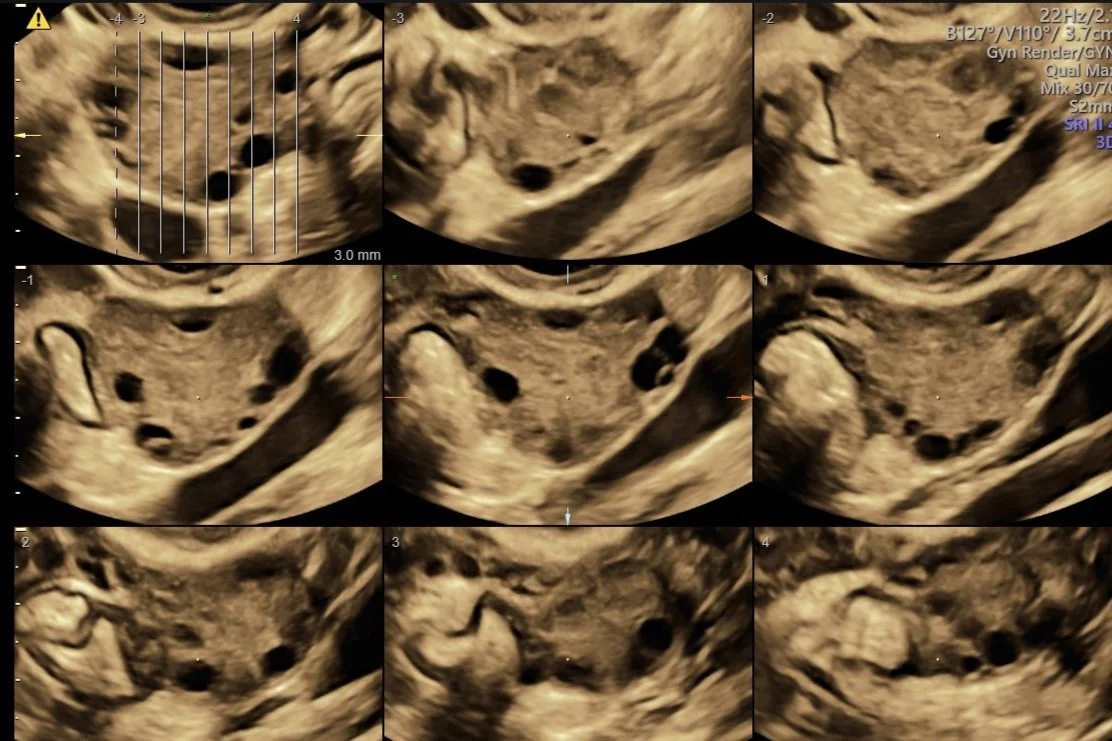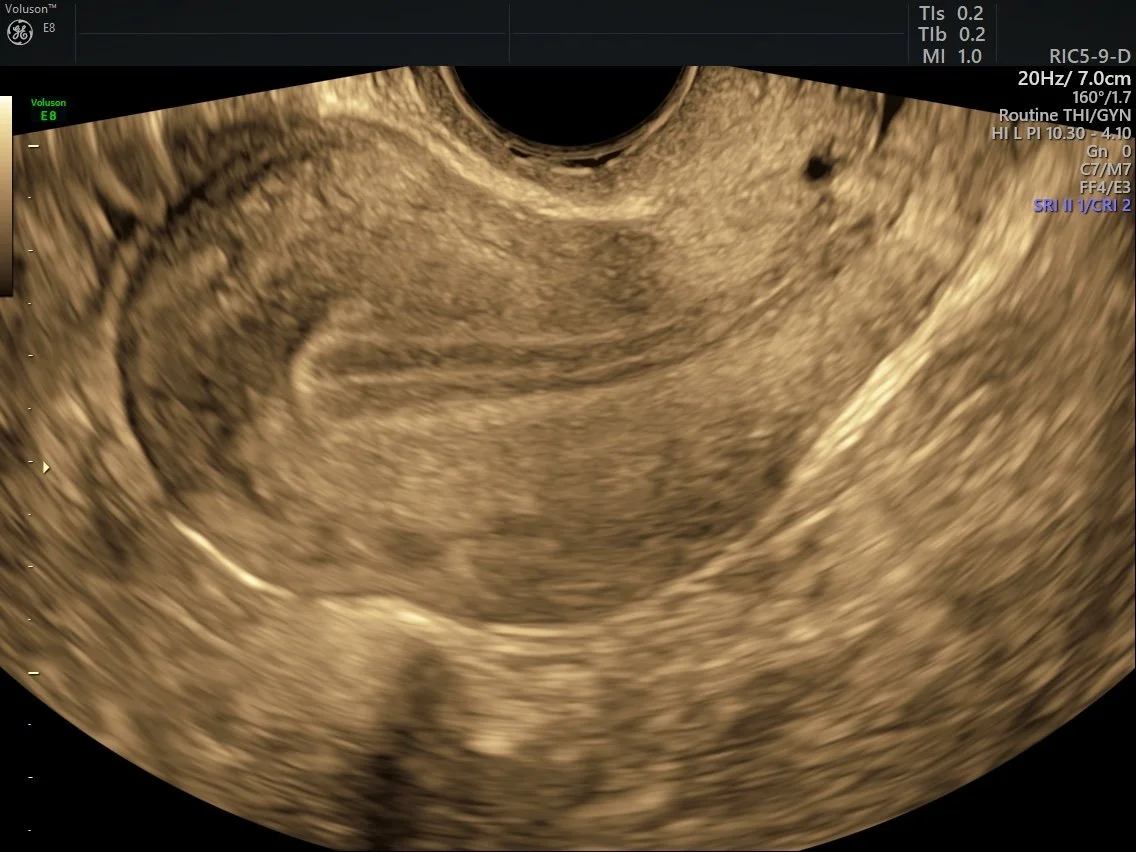
Gynaecological Scans
Pelvic Scans
A gynaecological ultrasound involves a detailed assessment of the female reproductive system, including the vagina, cervix, uterus, fallopian tubes, ovaries, anterior compartment and posterior compartment including a short portion of the bowel. The bladder and kidneys will also be assessed during your ultrasound of the pelvis.
Transvaginal ultrasounds are performed alongside a normal pelvic ultrasound, using a small, sterile probe. The transducer is covered in a disposable protective cover with lubricating gel.
The transducer is slightly thicker then a tampon and its long length provides a handle for the Sonographer to grasp for imaging purposes.
The insertion of the probe is similar to the insertion of a vaginal speculum that most women have experienced during a PAP smear examination.
Only a small portion of the transducer will be gently placed inside the Virginia. Following the insertion, the Sonographer moves the transducer from side to side, up and down to assess the pelvic organs and/or pregnancy. The Sonographer may also need to put pressure on the lower abdomen to move bowel out of the way and to bring the pelvic structures into view for assessment. These manoeuvres allow mobility of the organs to be assessed. It also helps to identify any points of tenderness for closer inspection with the probe.
The Transvaginal ultrasound examination is recognised as being safe without any significant risk. However, some women will have a small amount of discharge “spotting” following a Transvaginal examination due to the contact of the probe with the cervix. This is expected and not of any concern.
Is there a choice? Transvaginal or Transabdominal ultrasound?
At Trinity Imaging we only offer Gold standard protocols for the assessment of pelvic pathology and pregnancy assessments. Our Gold standard/protocol is to offer every female patient a Transvaginal assessment for gynaecological, early pregnancy, nuchal translucency, Morphology and Growth Scans. This is because the transducer is positioned close to the pelvic organs/pregnancy, producing superior image quality, allowing more accurate and detailed diagnosis.
Though its our practice’s protocol to offer a Transvaginal ultrasound, the patient may decline and instead be scanned Transabdominally. It is your decision whether to proceed with the Transvaginal ultrasound.
In certain circumstances, a Transvaginal ultrasound is not advisable or not possible e.g. if a patient has not had vaginal intercourse before. A Transabdominal ultrasound will then be performed. However, Transabdominal ultrasound gives only limited diagnostic information.
-
To acquire the best diagnostic images possible, the examination is routinely performed Transabdominally, followed by a Transvaginal ultrasound (always with your written consent first).
-
We recommend you wear a separate top to bottoms; this allows changing for the examination easier.
If possible, we recommend wearing comfortable, loose-fitting clothing that provides easy access to the area being imaged. Two-piece clothing, with separate upper and lower garments, is preferable.
-
Most pelvic ultrasound are best performed Day 5- Day 11 of your cycle from the first day of your period. This is when the endometrium is at its thinnest. However, if the reason is not urgent, the ultrasound can also be performed just after your period is finished.
-
Women with pelvis pain can sometimes experience increased discomfort or pain during transvaginal scanning. To help manage any potential discomfort, you may want to consider taking a couple of pain-relief tablets before your appointment. Options include an anti-inflammatory medication such as Nurofen or Naprogesic, or paracetamol (with or without codeine) such as Panadol or Panadeine. You can discuss this further with your referring Doctor.
-
Please ensure that you empty your bladder 1 hour before the procedure and then drink 2 glasses (600ml) of water, holding it without emptying your bladder again. Please note that your appointment might be delayed if your bladder is not adequately full.
Once the decision has been made to the Transvaginal ultrasound, you will be asked to empty your bladder for the internal examination.
-
Please ensure that you empty your bladder 1 hour before the procedure and then drink 3 glasses (750ml) of water, holding it without emptying your bladder again. Please note that your appointment might be delayed if your bladder is not adequately full.
-
The examination usually takes 30-45 minutes. Most women find the Transvaginal examination much more tolerable than having a cervical PAP smear examination. However, the duration may vary depending on the specific reason for the examination and the complexity of the individual case.
-
If possible we recommend wearing comfortable, loose-fitting clothing that provides easy access to the area being imaged. Two-piece clothing, with separate upper and lower garments, is preferable.
Additionally, please ensure that you empty your bladder 1 hour before the procedure and then drink 2 glasses (600ml) of water, holding it without emptying your bladder again. Please note that your appointment might be delayed if your bladder is not adequately full.
-
Having some urine in your bladder can be beneficial for outlining the cervix and visualizing the relationship of the placenta with the lower uterus during imaging. It also helps to elevate the uterus from the pelvis into the abdomen, facilitating better visualization of the fetus.
You don't need to have a large amount of urine, and simply drinking a glass of water 30-60 minutes before your scheduled appointment is sufficient.
-
We welcome one adult support person, whether it be your partner or a family member, to accompany you during your Diagnostic scan. However, for specific reasons, we have implemented policies that prohibit children from attending Diagnostic ultrasound appointments. While we understand that this may be disappointing for families, it is essential to maintain a focused environment. Thus allowing the Sonographer to be able to concentrate during the scan whilst taking the necessary images and measurements. Occasionally, our sonographer may need to discuss unfortunate news found during your appointment and so this must be taken into consideration. The presence of children can introduce distractions that may impact the quality of the examination.




